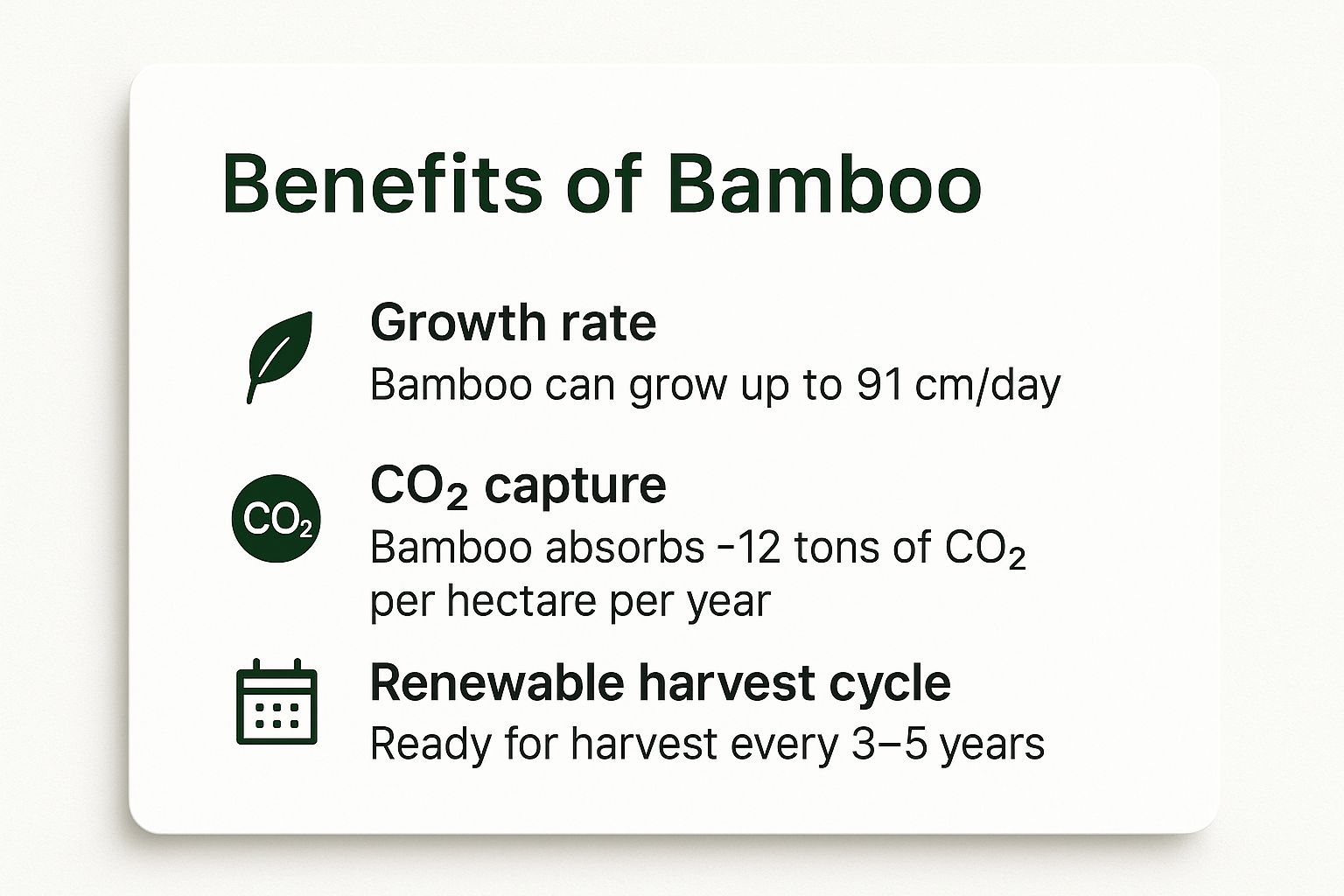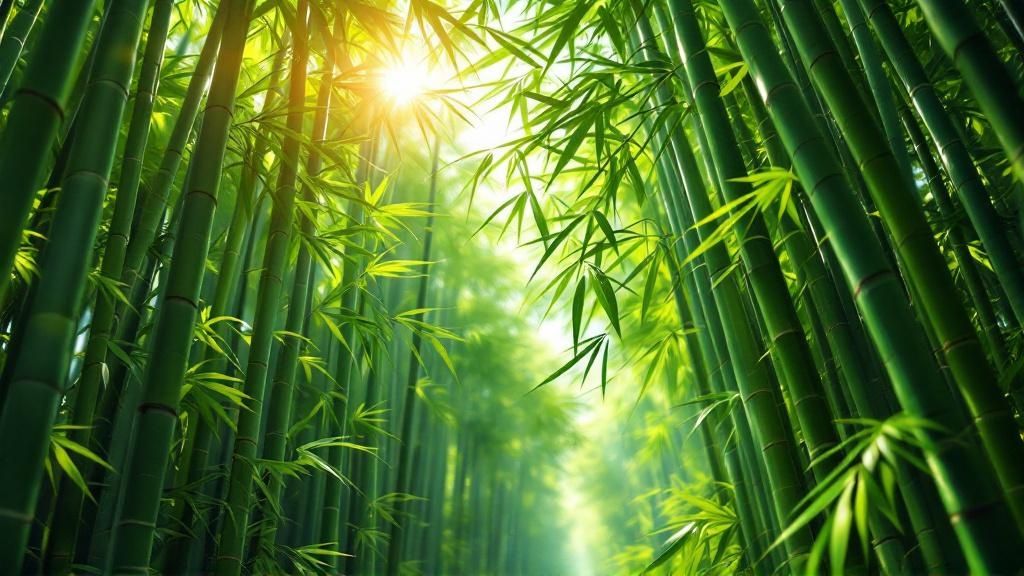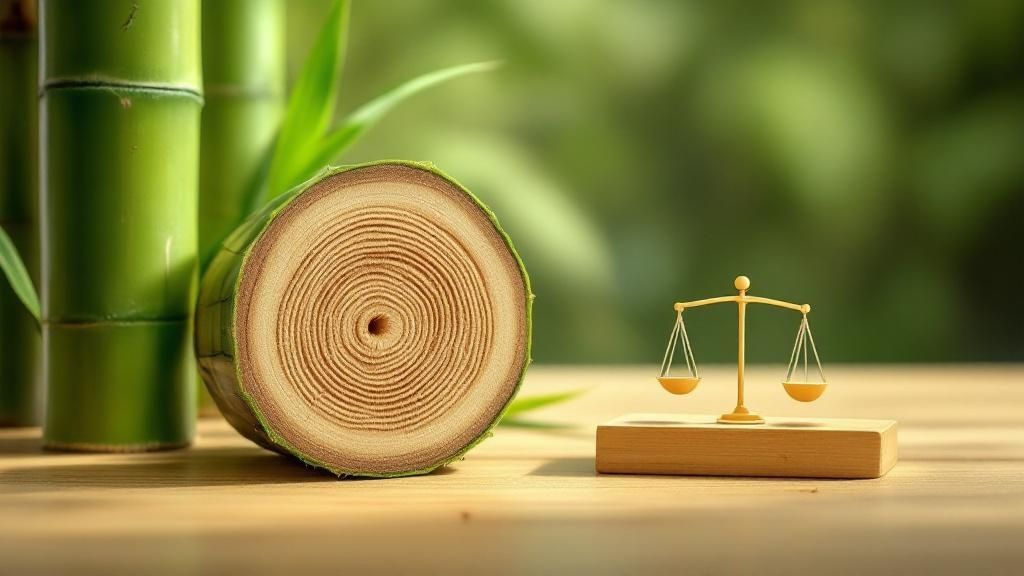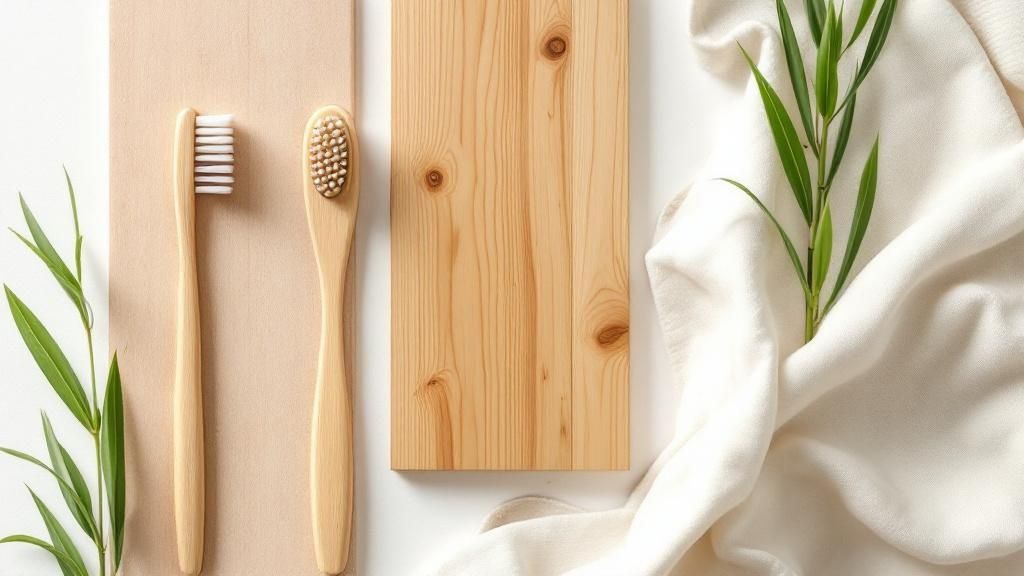When it comes to the core benefits of bamboo, it all boils down to its rapid renewability, impressive strength, and positive environmental impact. This isn't just another grass; it's a durable, eco-conscious alternative for everything from flooring to fabrics.
Bamboo's Rise As A Sustainable Powerhouse
If you're looking for truly sustainable materials, bamboo should be at the top of your list. It’s more than just a plant; it's a high-performance resource that helps tackle some of our biggest environmental challenges. Hardwood trees can take decades, sometimes a century, to mature. Bamboo, on the other hand, reaches its full height in just a few years. That makes it exceptionally renewable.
This rapid growth cycle is a complete game-changer. It means bamboo can be harvested on a regular 3- to 5-year cycle without causing deforestation. Better yet, the root system stays in place after harvesting, preventing soil erosion and allowing the plant to simply regrow on its own. This creates a reliable, continuous supply without the destructive clear-cutting we see with traditional timber.
A Deeper Look At Sustainability
To really appreciate its impact, it helps to see the numbers. This visual breaks down some of bamboo's most important environmental metrics, from its incredible growth rate to its ability to absorb carbon.

The data really drives home the point that bamboo’s benefits go far beyond speed. It actively helps clean the air and can be harvested responsibly, year after year.
Bamboo isn't just a substitute for wood; in many cases, it's an upgrade. Its tensile strength rivals that of steel, making it incredibly versatile for construction, furniture, and even textiles that demand durability.
This unique combination of strength and sustainability is precisely why you're seeing bamboo pop up in so many modern products. From sleek kitchen cabinets to soft, luxurious bedding, its versatility is practically unmatched.
If you're looking to embrace green living more broadly, this is a great starting point. For more ideas, check out this guide to selecting eco-friendly materials for sustainable homes, which shows how different choices can contribute to a healthier planet. The same principles that make bamboo a great option can be applied across your entire living space.
Bamboo Benefits At A Glance
To put it all in perspective, here's a quick comparison of how bamboo stacks up against traditional hardwood.
| Benefit | Bamboo | Traditional Hardwood |
|---|---|---|
| Growth Rate | Matures in 3-5 years | Matures in 20-100+ years |
| Harvesting Impact | Regenerates from roots; no replanting needed | Requires replanting; can lead to deforestation |
| Soil Health | Extensive root system prevents soil erosion | Clear-cutting can cause significant erosion |
| Carbon Sequestration | Absorbs more CO2 and produces 35% more oxygen | Good carbon sink, but over a much longer period |
As you can see, bamboo consistently offers a more sustainable and faster-growing alternative without sacrificing performance.
How Bamboo Actually Helps The Planet

We know bamboo grows fast, but its real magic lies in the profound, positive effect it has on the environment. It's a powerhouse when it comes to being a carbon sink, absorbing huge amounts of carbon dioxide while releasing over 35% more oxygen into the atmosphere than a similar stand of hardwood trees. This makes bamboo groves a genuinely powerful ally in the fight against climate change.
This natural efficiency isn't just happening above ground. When traditional forests are logged, the soil is often disrupted and left vulnerable. Bamboo is different. Its dense, interconnected root system—a rhizome network—stays completely intact after harvesting. This network acts like a natural net, holding the soil together, which prevents erosion and helps the ground retain precious water. The plant simply regrows from these roots, so there’s no need to replant.
A Master of Carbon Capture
When you dig into the numbers, bamboo's ecological superiority really shines. It’s a champion of carbon sequestration, pulling CO2 out of the air with remarkable efficiency. This is a huge reason why it’s become such a valuable resource for a healthier planet.
Consider this: bamboo can store roughly 12 tons of carbon per hectare each year. In comparison, a typical forest captures somewhere between 6-8 tons. This incredible efficiency is why bamboo is becoming a cornerstone of circular economy initiatives, offering a sustainable alternative to slow-growing timber.
By choosing bamboo, you're not just picking a durable material. You're actively supporting a system that regenerates soil, purifies the air, and promotes biodiversity—all without the destructive footprint of deforestation.
These environmental wins are passed on to every product made from this amazing plant. For example, the creation of bamboo textiles is built on these same sustainable principles. You can learn more about this in our guide to bamboo fabric benefits.
Bringing this eco-conscious mindset into other parts of your daily life can amplify your positive impact. If you're passionate about sustainable living, you might find it rewarding to explore other durable and eco-friendly choices for your home. Every small switch adds up to a healthier planet.
Strength and Versatility in Modern Design

Beyond the green credentials, what really makes bamboo a game-changer is its surprising combination of strength and flexibility. It’s a fact that often catches people off guard: bamboo has a higher tensile strength than many steel alloys. That means it can handle more stress and tension before breaking, making it an incredibly reliable material for some pretty demanding jobs.
This built-in resilience is precisely why bamboo has broken out of its traditional role in decorative items. It’s now a serious player in industries that have long relied on wood, plastic, and even metal. From structural beams in ambitious architecture to durable planks for high-traffic flooring, bamboo is proving it can perform.
A Go-To Material for Modern Innovation
Designers and engineers are constantly finding new ways to put bamboo's unique properties to work. We’re seeing laminated bamboo lumber used to create stunning, modern rooflines or sturdy, elegant furniture that’s built to last for decades. Its light weight, paired with its incredible strength, just opens up a world of new design possibilities.
Here are just a few of the areas where bamboo is making a real impact:
- Construction: It's used for everything from scaffolding and structural supports to composite building panels.
- Flooring and Furniture: Thanks to its natural hardness, it stands up well against scratches and dents, perfect for everyday life.
- Textiles: Bamboo fibers can be spun into unbelievably soft, durable, and breathable fabrics for clothing and bedding.
- Automotive Interiors: Some car manufacturers are even using bamboo composites for dashboards and trim, loving its sleek look and sustainable story.
This surge in popularity isn't just anecdotal. The global market for bamboo products was recently valued at around USD 25.4 billion, which speaks volumes about the growing demand. If you're interested in the numbers, you can dig deeper into this trend with this detailed report on bamboo products.
Bamboo's versatility comes down to a simple truth: it gives you the strength of a hardwood with the rapid renewability of a grass. This unique blend makes it a superior choice for both the planet and your project.
At the end of the day, bamboo’s physical specs show it’s not just an eco-friendly substitute but often a better-performing one. It delivers the durability we all need without the heavy environmental toll of traditional materials, cementing its place as a key material for the future.
The Booming Economics of the Bamboo Industry
It’s easy to focus on bamboo’s environmental benefits, but the story doesn't end there. Bamboo is also a serious economic powerhouse. We're not talking about a small, niche market—this is a massive global industry that's gaining steam every year, thanks to savvy consumers demanding better, more sustainable products.
This growth has been a game-changer for rural communities, especially in the Asia-Pacific region where most of the world's bamboo is grown. For millions of people, bamboo cultivation offers a steady, reliable livelihood. It’s creating jobs at every level, from farming and harvesting to processing, manufacturing, and shipping goods worldwide.
A Market Gaining Serious Momentum
The numbers don't lie. The global bamboo market is already valued at an impressive USD 67.43 billion and shows no signs of slowing down. In fact, projections have it soaring to USD 102.38 billion with a Compound Annual Growth Rate (CAGR) of 4.75%.
While the Asia-Pacific region is the current heavyweight champion of production, North America is the fastest-growing market. This tells us that bamboo isn't just a regional trend; it's being embraced everywhere. You can dive deeper into the data on the bamboo market's growth.
This economic momentum is showing up in the products we see on shelves every day. As more and more of us look for eco-friendly alternatives, the demand for everything from bamboo flooring to kitchen utensils has exploded.
Choosing bamboo isn't just an environmental statement; it's a vote for a global industry that supports sustainable agriculture, fosters rural development, and offers a robust alternative to less eco-friendly supply chains.
The sheer versatility of bamboo is a huge part of its economic success. This humble plant can be transformed into high-value, premium goods—like incredibly soft and durable textiles. Learning about what bamboo sheets are really highlights how a fast-growing crop becomes a sought-after luxury item.
Ultimately, the thriving economics behind bamboo prove that sustainability and profitability can absolutely go hand-in-hand. When you support this industry, you’re helping to build a greener, more resilient global economy.
Bringing Bamboo into Your Everyday Life

Knowing about bamboo's benefits is great, but the real magic happens when you start bringing it into your home. The good news? It’s never been easier to make simple, sustainable swaps. You don't have to overhaul everything at once; just start small and see where it takes you.
Take a look at your daily routines. The bathroom is a fantastic place to begin—think about swapping your plastic toothbrush for a bamboo one. In the kitchen, plastic cutting boards and utensils can easily be replaced with durable, naturally antibacterial bamboo alternatives. These small changes really do add up, cutting down on plastic waste while bringing a touch of natural style to your home.
Making Smart Bamboo Choices
When you’re ready to consider bigger items like furniture or flooring, it pays to be a savvy shopper. Not all bamboo products are created equal, so a little know-how will ensure you’re getting something that’s genuinely sustainable.
The key is to look for markers of quality and responsible sourcing.
-
FSC Certification: The most important thing to look for is the Forest Stewardship Council (FSC) seal. This is your guarantee that the bamboo was harvested from a responsibly managed forest that protects the environment and its workers.
-
Low-VOC Finishes: Pay attention to the adhesives and finishes used. Always opt for products with low-VOC (volatile organic compounds) to maintain healthy indoor air quality for your family.
Choosing a product with an FSC label means you’re directly supporting a supply chain that puts ecological health first. It’s a straightforward way to confirm you’re making a truly green purchase.
One of the most popular ways people experience the luxury of bamboo is through textiles. You can find out all the reasons bamboo sheets are better for a comfortable, healthy night's sleep. From their incredible softness to their hypoallergenic qualities, they’re a perfect blend of comfort and sustainability.
Got Questions About Bamboo? Let's Clear Things Up.
Even with all the obvious upsides, it's smart to have a few questions before bringing a new material into your home. Let's walk through some of the most common things people ask about bamboo so you can feel totally confident about its performance, care, and true strength.
A question I hear all the time is whether bamboo is really stronger than wood. The answer usually comes as a surprise: yes, it often is. Some types of bamboo have a tensile strength that can compete with steel, which is a measure of how well something resists being pulled apart. This incredible durability makes it a fantastic choice for things that take a lot of abuse, like flooring and furniture, often outperforming traditional hardwoods.
How to Take Care of Your Bamboo Gear
The great news is that keeping your bamboo products in top shape is pretty simple. With just a little attention, they'll last for years.
For anything in the kitchen—think cutting boards and utensils—your best bet is a quick hand-wash with gentle soap and warm water. Just try not to let them soak, and definitely keep them out of the dishwasher. The intense heat and moisture in a dishwasher can make the bamboo swell or even crack over time. A quick rubdown with a bit of food-grade mineral oil once a month will also keep it from drying out and looking great.
Taking care of bamboo flooring is a lot like looking after hardwood floors.
- Sweep it regularly: Grab a soft-bristle broom or use a vacuum (just make sure the beater bar is turned off!) to get rid of the daily grit and dirt that could cause scratches.
- Mop gently: A damp mop is all you need. Use a pH-neutral cleaner made for wood or bamboo floors, and remember, less water is more.
- Clean up spills right away: Don't let spills sit. Wiping them up immediately prevents moisture from getting a chance to soak in.
I think there's a myth that because bamboo is a type of grass, it's extra vulnerable to water. The truth is, once it's been properly sealed and finished, bamboo holds up incredibly well against everyday humidity and moisture.
Is All Bamboo Sourced Sustainably?
This is a really important question, and the short answer is no—not all bamboo is sourced with the same care. The bamboo material benefits you're looking for are only truly realized when it comes from a responsibly managed forest.
To make sure you're getting the real deal, always look for products with a certification from the Forest Stewardship Council (FSC). This little seal is a big deal. It guarantees the bamboo was harvested in a way that protects the local ecosystem, respects workers' rights, and keeps the forest healthy. Without it, you're just guessing. By choosing certified products, you’re not just buying a great material; you're supporting the people doing it right.
Ready to experience the incredible comfort of sustainably sourced bamboo? Bamtek offers 100% organic, OEKO-TEX certified bamboo bedding designed for a healthier, more luxurious sleep. Discover the difference at https://bamtekhome.com.










